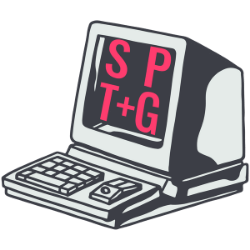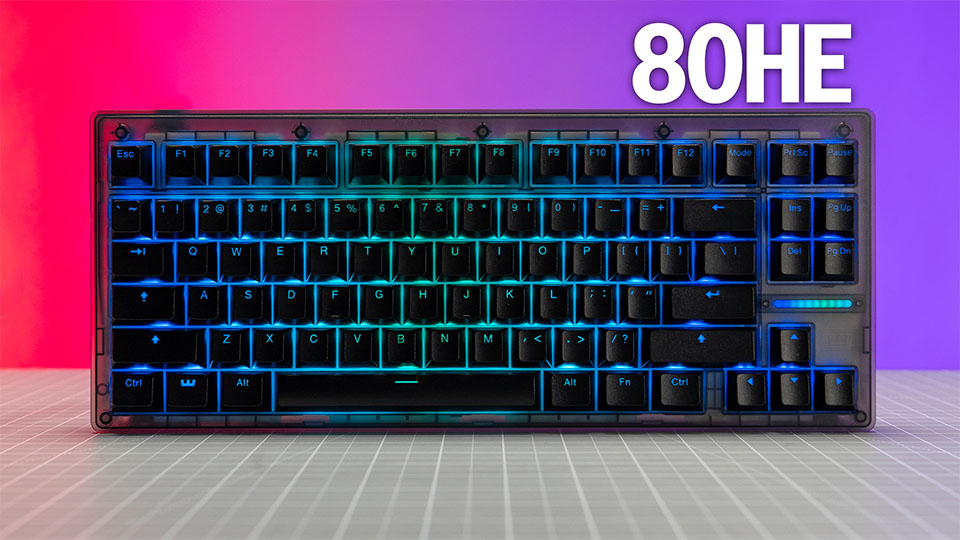Links in this post may be affiliate links. Any products purchased through affiliate links may provide a small commission which helps to support the SemiPro Tech+Gear site and YouTube channel.
Hall Effect (HE) keyboards have been increasing in popularity for the last couple of years, and Wooting has been a pioneer since 2015. While I’ve reviewed several HE keyboards at this point, I haven’t gotten my hands on a Wooting board until now. Enter the Wooting 80HE, a keyboard boasting an ultra-low latency of less than 0.5ms and a wealth of customization options. But does the 80HE stand up to the recent advances made by HE competitors? Let’s take a deep dive and find out.
Before we dive in I want to mention that Wooting sent me the 80HE for the purpose of reviewing it. No money changed hands and Wooting did not provide any input on the review or see it before publishing. In fact, they encouraged me to take my time to test the 80HE (I tested it for a little over a week).
Wooting 80HE
MSRP: $199 (ABS case) / $289 (zinc case)
Pros
- Fantastic raw gaming performance
- Tons of HE customization
- Great feel & sound vs. HE competition
- Nice RGB
Cons
- No firmware macros
- ABS case is light and a bit too flexible
- A tad pricey for a plastic keyboard
Best For: When you want the best performance and thocky sound, and don’t mind paying for it.
Specifications
The Wooting 80HE is available in two main configurations with either an ABS or zinc alloy case. The ABS model, which I tested, is lightweight and enhances RGB visibility with its translucent Ghost design, while the zinc alloy version provides a more premium, weighty feel. Below are the key specifications:
- Layout: 80% (84 keys), available in ANSI, ISO, and JIS configurations
- Build Material: PCR ABS plastic (solid black or Ghost translucent); zinc alloy case option
- Dimensions: 346 x 142mm
- Height: 19.4mm (front), 26.5mm (rear) without keycaps
- Weight: 790g (ABS model), 2,160g (zinc alloy model)
- Typing Angles: Three adjustable positions with removable silicone feet
PROS & CONS
PRO: Ultra-Low Latency & Tachyon Mode
One of the standout features of the 80HE is its performance. It boasts an 8,000Hz polling rate and an 8,000Hz PCB scan rate when Tachyon mode is enabled, resulting in an incredibly low 0.4ms latency. This isn’t just a marketing claim—independent testing by rtings.com confirmed it. To put this in perspective, the NuPhy Field75 HE, one of the few other keyboards in the same ballpark of performance, achieved 0.8ms latency but with a lower 2,500Hz scan rate.
However, while sub-1ms latency is impressive, only elite players will notice the difference between 3-4ms and 0.4ms. The rest of us mere mortals are unlikely to really get a bump in gaming results compared to a latency in the 3-4ms range because our own reaction time is the biggest factor. But if you’re coming from a productivity-focused keyboard with significantly higher latency, you won’t get a bigger improvement in performance than the 80HE.
Tachyon mode, which enables the 8,000Hz scan rate, disables RGB effects to ensure sufficient power allocation. It’s useful to have separate profiles, keeping it enabled for gaming and disabled for everyday use. When off, the scan rate is 1,600Hz; plenty for productivity work and when you want to get the most out of your RGB effects.
PRO: Customization via Wootility
The 80HE offers extensive customization through the Wootility web app, which allows users to remap keys, adjust RGB lighting, and fine-tune Hall Effect settings. The software provides four customizable profiles that can be switched on the fly. Key actuation points are adjustable from 0.1mm to 4mm, allowing for a tailored typing and gaming experience. For daily use, I set my actuation point to 1.2mm too many typing errors with rapid trigger and Tachyon mode disabled.
Rapid Trigger functionality is present, enabling ultra-fast repeated key presses without requiring full key release. Advanced features like Rappy Snappy, Snappy Tappy, Dynamic Keystroke, Mod Tap, and Toggle Key add further depth to customization, though their names can be confusing for newcomers. Wootility does a good job simplifying adjustments, making these advanced settings about as simple as they can be. It’s worth noting that Snappy Tappy is the feature that has been banned by some online games due to the competitive advantage it can give the user. This feature can be set assigned to two keys like your right/left movement and be set to transmit the last key that is pressed, even if the prior key is still being held down. That means you don’t have to release the right/left key before starting to move in the other direction, shaving milliseconds off the time it takes to make rapid strafing movements common in FPS games. While you may not be able to use this feature in online gaming, you can still use it in gameplay that doesn’t involve other users.
PRO: Feel and Sound
The 80HE delivers an excellent typing experience, especially by HE keyboard standards. Compared to other HE keyboards I’ve tested, this one stands out in terms of feel and acoustics. The combination of a polycarbonate plate, silicone dampening between the PCB and plate, and pre-lubed stabilizers results in a slightly softer bottom-out and a deeper, thocky-er, sound than some competitors like the NuPhy Field75 HE. It’s common for HE keyboards to use firm mounts and aluminum or steel plates, which can result in a dull or hollow sound and much firmer feel that can be kind of monotonous and fatiguing when you’re using the keyboard for both everyday productivity and gaming. So the 80HE is a welcome combination of both excellent performance and enjoyable sound & feel.
The Lekker L60 V2 switches included in the prebuilt model have a 60g bottom-out force, and they feel great—smooth, consistent, and without excessive wobble. There’s also a lighter L45 V2 option for those who prefer a lighter weight. But you can also move the actuation point up higher if the weight feels a little too heavy.
Additional Pros
- Build Options – Available as a PCB module with no case, with an ABS or zinc alloy case, and multiple keycap choices.
- Impressive RGB & Keycap Quality – Shine-through PBT keycaps and customizable lighting enhance the experience. The RGBs are bright and north-facing for proper legend illumination, and the ABS Ghost case allows some RGB to shine through.
- Broad Compatibility – Works with Windows, macOS, Linux, and even PS4 (with 6-key rollover mode). It’s also available in ANSI, ISO, and JIS layouts.
- Excellent Warranty – Wooting offers a 4-year warranty (2 years for LEDs), significantly above the industry norm of 1 year.
Neutral Points
Every keyboard (and every other thing that exists) has some points I have to call neutral because they are very subjective and not inherently good or bad to everyone. The best example is design aesthetics – whether you like the visual design of the 80HE is up to you and there’s no right or wrong answer. Some additional neutral things to consider:
- ABS Case Feel – The translucent Ghost design enhances RGB, but the plastic feel may not suit everyone. It is, afterall, a plastic keyboard that costs $200.
- Compact 80% Layout – The arrow cluster and navigation keys are more compact than a traditional TKL.
- No Default macOS Profile – Requires manual remapping of the modifier keys for optimal Mac compatibility. This is easy with Wootility, but just FYI you will have to do this yourself. You can save a separate Mac profile as one of your four profiles if you use both Mac and Windows.
- Customer Service Response Times – Wooting has acknowledged delays with tech support inquiries but they have stated they are working to improve support. Check out their YouTube channel for updates – they are pretty transparent about it which is great.
Cons
While the list of Pros for the 80HE was long, there are a couple of cons, but not all of them will impact everyone.
- Lack of Onboard Macros – Unlike competitors like NuPhy, macros require the Wootomation software (Windows/Linux only). This means you cannot create macros and bind them to keys directly on the keyboard. Instead you have to use the software to create macros and it must be running on your computer for them to work. This feels like a missing feature at this price point, considering the $99 NuPhy Halo65 HE offers similar gaming performance and customization, plus firmware macros.
- Lightweight ABS Case & Flex – While I personally like the look of the ABS ghost case, it does have a couple of downsides. First, because of its light weight, it moves around on some desk mat materials fairly easily. On a hard surface it stays put for the most part thanks to the rubber feet, but they don’t have enough grip to keep it from moving around on my felt desk mat. It also flexes a bit too easily – and I don’t mean typing flex. I mean you can bend the case too easily, which doesn’t exude quality. The zinc alloy case should solve both of these issues, however.
- Premium Pricing – At $199 for the ABS version and $289 for the zinc alloy case, it’s on the expensive side. The price for the ABS model feels a tad high for a plastic keyboard in general, even with the high performance and customization. And while the zinc alloy case would make it look and feel more premium, nearly $300 is going to be out of reach for a lot of gamers.
Is it Worth It?
The Wooting 80HE is an outstanding HE keyboard, particularly for gamers who demand the lowest possible latency and deep customization. It offers top-tier performance, a well-thought-out software suite, and excellent typing feel and sound. However, the lack of firmware-based macros, some flex in the ABS case, and its relatively high price prevent it from being easy to recommend to all users. If you need onboard macros and would welcome a more wallet-friendly price, the $99 NuPhy Halo65 HE or $149 Field75 HE are worth a look.
Ultimately, if gaming performance is your top priority, the 80HE is one of the best options available. I’ll also be reviewing the 60HE+ soon, along with a zinc alloy vs. ABS case comparison, so stay tuned for those.



